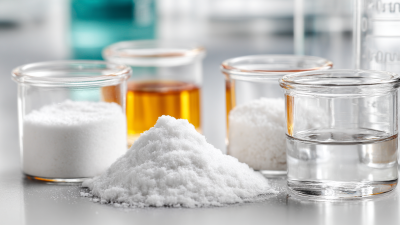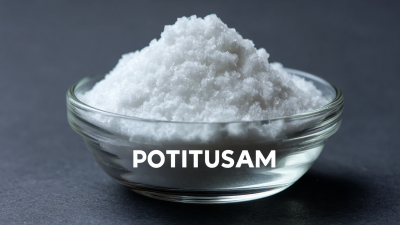In the wake of the COVID-19 pandemic, the role of disinfectant manufacturers has become increasingly vital in ensuring public health and safety. According to a report by the Global Disinfectant Market, the market size is projected to reach $10.8 billion by 2027, growing at a compound annual growth rate (CAGR) of 8.5% from 2020. This surge underscores the importance of quality disinfectant products in various settings, including healthcare facilities, schools, and public spaces.

As consumers demand more effective and environmentally friendly solutions, disinfectant manufacturers are tasked with innovating their product lines and enhancing production processes. In this post-pandemic landscape, they not only contribute to immediate sanitation needs but also play a critical role in shaping the future of hygiene practices. Thus, understanding their impact and strategies is essential for navigating this evolving market.
In the wake of the COVID-19 pandemic, the role of disinfectant manufacturers has evolved significantly. These companies have become essential players in ensuring public health and safety by developing products that effectively kill viruses and bacteria. The increased demand for disinfectants has pushed manufacturers to innovate rapidly, enhancing formulas and expanding their product lines to cater to various environments, from hospitals to schools and everyday households.
Tips for consumers to choose effective disinfectants include checking for EPA registration, which indicates that a product meets specific safety and efficacy standards. Additionally, it's important to read labels carefully, looking for active ingredients like bleach or alcohol, which are proven to be effective against pathogens. For maximum effectiveness, follow the manufacturer's instructions regarding contact time to ensure that germs are fully eradicated.
As we adapt to a post-pandemic world, disinfectant manufacturers must continue to embrace sustainability and safety in their production processes. This includes developing eco-friendly products that do not compromise on effectiveness while being less harmful to users and the environment. By prioritizing both health and environmental considerations, manufacturers can meet the evolving demands of consumers while contributing to a safer world.
| Category | 2020 Demand (in units) | 2023 Demand (in units) | % Increase | New Product Launches (2022) | Sustainability Initiatives |
|---|---|---|---|---|---|
| Household Disinfectants | 50 million | 80 million | 60% | 15 | Biodegradable Packaging |
| Industrial Disinfectants | 20 million | 35 million | 75% | 8 | Water-based Formulas |
| Healthcare Disinfectants | 15 million | 25 million | 67% | 10 | Eco-friendly Ingredients |
| Surface Disinfectants | 30 million | 50 million | 67% | 12 | Recyclable Materials |
The COVID-19 pandemic has dramatically reshaped the landscape of public health, necessitating the development of innovative disinfectants to combat a wider array of pathogens. According to a report from Grand View Research, the global disinfectant market is projected to reach $37.76 billion by 2027, demonstrating a CAGR of 7.9% from 2020 to 2027. This growth underscores the urgency for manufacturers to innovate formulations that are not only effective against existing viruses and bacteria but also adaptable to emerging threats.
With evolving pathogens and the possibility of new outbreaks, disinfectant manufacturers are focusing on multi-faceted formulations that include active ingredients capable of addressing antibiotic-resistant bacteria and viruses. Research indicates that traditional formulations may no longer suffice; therefore, manufacturers are integrating novel compounds and technologies to enhance efficacy and sustainability. For instance, the incorporation of nanotechnology has been shown to amplify the antimicrobial properties of disinfectants, increasing effectiveness against a broader spectrum of pathogens. As the industry evolves, the emphasis on R&D is vital for creating disinfectants that meet the changing demands of public safety in a post-pandemic world.
In a post-pandemic world, disinfectant manufacturers are faced with the challenge of navigating a rapidly evolving landscape of regulatory compliance and safety standards. According to a report by the American Association of Poison Control Centers, there has been a dramatic increase in the usage of disinfectants, leading to a heightened scrutiny on ingredient safety and labeling accuracy. Manufacturers must adapt to new guidelines set by organizations such as the EPA, which now require rigorous evidence to substantiate claims of efficacy against emerging pathogens.
Furthermore, the International Organization for Standardization (ISO) has introduced updated standards for chemical disinfectants, mandating comprehensive testing practices to ensure the safety and effectiveness of products. In 2021, the ISO reported that non-compliance with these regulations could lead to severe penalties, including product recalls and damage to brand reputation. As the industry grapples with these regulatory shifts, it is essential for manufacturers to invest in ongoing training and development to ensure their products meet or exceed the updated safety standards. Continual adaptation and compliance will not only safeguard public health but also enhance consumer confidence in disinfectant products in this new normal.
This chart illustrates the compliance rates of disinfectant manufacturers with various safety standards over the past few years, reflecting the impact of the pandemic on regulatory changes.
In the aftermath of the COVID-19 pandemic, the demand for disinfectants surged, leading to a notable shift towards eco-friendly products amidst rising health consciousness. A report by Grand View Research indicates that the global disinfectant market is projected to reach USD 23.4 billion by 2026, driven primarily by the growing preference for environmentally sustainable products. This trend reflects not only a shift in consumer behavior but also a larger movement towards sustainability in various industries. Manufacturers are now focusing on developing formulations that are both effective in killing pathogens and safe for the environment.

As consumer awareness increases, companies are reformulating traditional disinfectant products to incorporate natural ingredients and biodegradable materials. A study by Research and Markets highlights that eco-friendly disinfectants are expected to grow at a compound annual growth rate (CAGR) of 12% through 2028. This evolution in the product lineup underscores the manufacturers' dedication to reducing their ecological footprint while maintaining the efficacy of their products.
Tips: When selecting disinfectants, prioritize products with eco-certifications to ensure they have met environmental standards. Additionally, consider the packaging; choosing brands that use recyclable materials contributes to reducing plastic waste. Lastly, check ingredient lists for natural alternatives to harsh chemicals, which can be equally effective and safer for households.
In a post-pandemic world, the role of disinfectant manufacturers has evolved significantly, particularly regarding supply chain strategies. Ensuring consistent availability of disinfectants during crisis situations is paramount, as public health and safety heavily depend on efficient access to these critical products. Manufacturers are now tasked with reinforcing their supply chains to mitigate risks related to disruptions caused by pandemics, natural disasters, or geopolitical tensions. This includes diversifying suppliers, evaluating sourcing strategies, and investing in robust inventory management systems.

Additionally, collaboration within the supply chain network has become essential. Disinfectant manufacturers must work closely with suppliers, distributors, and retailers to ensure real-time information flow and adaptability. Implementing technology solutions such as predictive analytics can aid in anticipating demand fluctuations, allowing companies to respond swiftly to changes. Furthermore, building strong relationships with local suppliers can enhance agility and resilience in times of crisis, enabling manufacturers to maintain a steady supply of products even when faced with unforeseen challenges.






